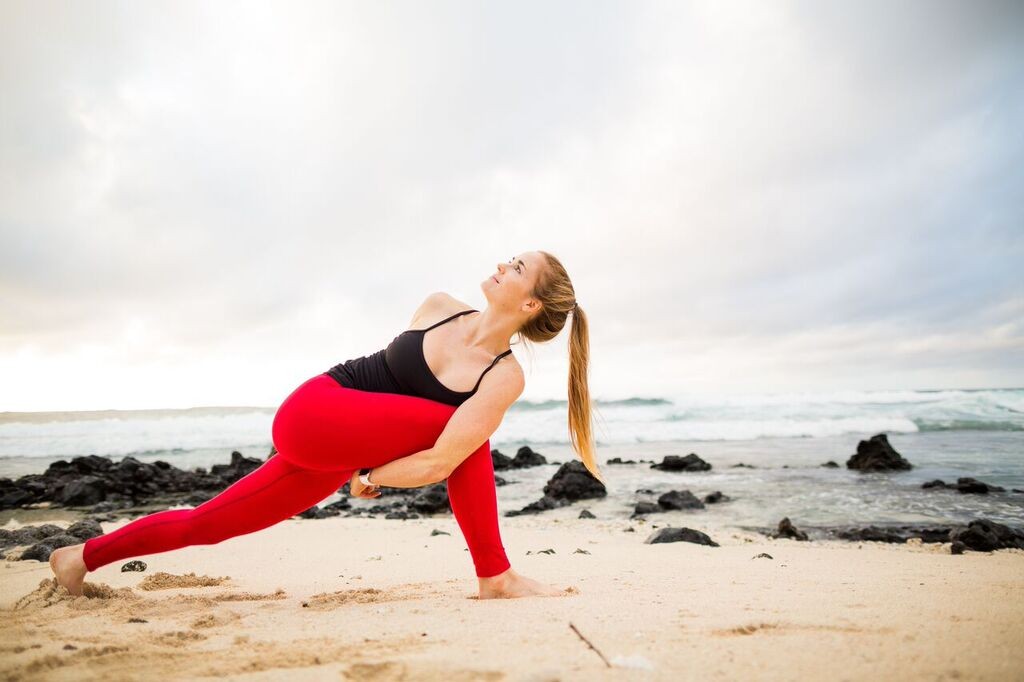
ALOHA yogis!
Everyone loves a twisting class. I want to share some thoughts on the practice of twisting with you. I definitely don’t want to make baseless claims that lack scientific evidence, but for teachers and students alike it is always an interesting practice between trusting what you feel in your body over what the Western medical evidence for yoga benefits might reveal. There is a major lack of research in this area, at least on a larger scale. I studied yoga benefits in grad school but only for a small cohort of around 30 yogis.
Let’s dive deeper into the topic of twists: the alignment, benefits, contraindications, and myths.
What is physically happening in a twist? The action of twisting, rotates the spine and helps to stretch the muscles throughout the back body. A safe twisting practice will help to restore the spine’s natural range of motion. If we don’t continue to practice finding our spine’s natural range of motion, we could, not surprisingly, lose some of that mobility, our joints may harden or even fuse. The supportive muscles around the spine can also become shortened, however, if we practice daily twists we can hopefully maintain full mobility and function.
There are some really important fundamentals of twisting, and the most important is the action of lengthening the spine before adding any physical rotation or twist. The inhale breath coincides with the action of lengthening so as to create space between the vertebrae. When there is little space or length between vertebrae the spine may slump or have a pinching sensation. Additionally, the sushumna nadis lies along the spine, our major channel of energy flow, through all 7-chakras or our "bulbs" of energy. If there is a stop in the flow of our energy, it’s no bueno for our state of mind, we might feel our energy levels drop, or even our mood. A twist on your yoga mat will help you lengthen your spine and eventually create space between the bones, so that our energy can flow more efficiently through our sushumna nadis. The immediate benefit from a twist is energy as we safely lift and decompress the vertebrae.
I love to sequence twists throughout a yoga practice, but especially at the end of a more focused class, such as a workshop on back-bending or forward folds. Twists are neutralizing postures, as they engage your core, abdominals, obliques, and the synergistic muscles that support different movements of your spine, shoulders, pelvis, and neck. Twists are a whole body effort. Be very wary if you enter a twist without a long spine and or without steady breathing, it means that something is off.
Now for the piece I really want to cover, do twists really aid in digestion? You’ve probably heard in class after class, twists are “detoxifying,” “great for digestion,” “cleaning your insides,” or maybe even “wringing out your internal organs,” etc. Before or after a big food holiday, such as Thanksgiving, you will definitely see a twisting class up on the schedule. What do all of these claims actually mean? And are they claims or truth? Twists create movement through our torso, including, in and around our organs, so they do help speed things up in terms of digestion by encouraging our food along.
BKS Iyengar believed that twists are detoxifying because of the squeeze and soak action. The organs of detoxification and elimination are compressed pushing out old blood, when we release the twist fresh blood can flow in. This is widely accepted in the yoga world, but like many things in life, there is some healthy debate on this topic.
Others suggest that the concept of the ‘squeeze and soak’ action is not that accurate. “Twists do affect our mobility (movement of organs in relation to each other) and our motility (movement within an organ). However a number of factors are involved in stimulation of our organs” (Yoga Anatomy, Matthews).
It would be safe to say that twists help stimulate circulation to our organs, including our organs of elimination, which in turn can help stimulate our metabolism and rate of excretion.
Perhaps twists aren’t literally “wringing out the internal organs” just as in a backbends aren’t literally “opening your heart” but there is a grain of truth to both metaphors as we certainly feel energetic releases to the organs of that particular area and they can be helpful guiding metaphors for us on our mats, to deeply connect to the posture and its intention.
I usually start off every class by asking my students if they have any requests, and one of my students always says, “well, you know I am pro-twists, as always!” (I adore her). After a long day at the office, sitting, traveling, just living, here are some good reasons to insert twists into your daily life. Twists stimulate circulation, they create heat, release tension in the muscles of the spine, abdomen and rib cage which has a carryover effect of helping the other systems in the body work effectively.
There are countless twisting postures and they could be seated, standing, or supine. A supine twist stabilizes the upper body, therefore allowing the twist to happen through the lower spine by rotating the pelvis and legs. Be sure to draw your belly in and keep both shoulders grounded. In a seated or standing twist we must both ground ourselves and lengthen through the spine, draw your belly up and in so as to stabilize the pelvis and low back. If seated root down through the sitting bones and if your back rounds, prop yourself up onto a bolster, blanket, or block to maintain the natural length and curvature of your spine before adding in a twist.
Both students and teachers should be aware that different parts of the spine have different ranges of mobility. Knowing this takes some self-imposed pressure off of yourself that you “should be” somewhere you are not or quite frankly somewhere you will never be. Your body will tell you where you need to be, but if that isn’t good enough, know that anatomically your spine will have varying degrees of mobility. The lumbar spine rotates only about 5 degrees, the thoracic spine rotates about 35 degrees, and the cervical spine rotates about 50 degrees. Practice very mindfully, and work the whole spine into your twist, with all of its degrees of mobility, be patient and kind to yourself. Start with the low body, and work your way on up, allow your neck to twist very last.
If your body is restricting a movement, don’t force it, breathe, be present, listen to your body’s wisdom and adapt your posture.
There is also some debate about what is going on in the pelvis and hips in your twist. Some yoga instructors will say the hips should be completely level or if seated, that the sitting bones should be completely fixed to the floor in a twist. This would make for a deeper twist in the more mobile areas of the spine, ie thoracic. However, if you are doing this rather than just engage your quads, you must really draw the thigh bones into the hip sockets. Because the other school of thought is that it is easier on the SI joint to let the opposite hip to the side you are twisting lift slightly, and this is a much more natural movement for the body. As you know, hips are not only the largest joint, but it is a big area of injury for yogis. Twists are contraindicated if you are pregnant! Skip the twisting portion of class if you are pregnant. There are other modifications you can take if you are a mama-to-be!
If you are in a twist, aligned well, comfortable through the hips, shoulders, etc., you might be ready to deepen your expression with a bind. Twists open the back, shoulders, and chest nicely. Let’s cover binding on another day. Let your takeaways today be: listen to your body, breathe, lengthen through your spine before adding any rotations, and stay present.
Happy Twisting,
LM
